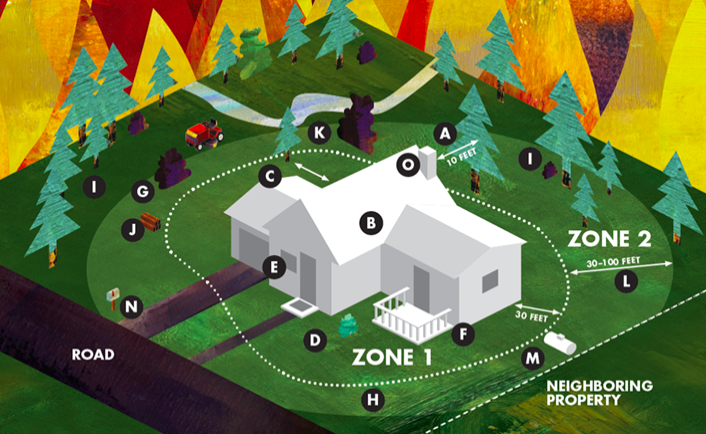National Preparedness Month: Creating Defensible Space

With the increase in fires in the West, chances are a wildfire may come near your home. It is your responsibility to prepare and maintain the area around your home to reduce risk and create space to make it easier for fire crews to protect your home in case of fire. Drawing from resources prepared by CALFIRE, this post offers practical tips for creating defensible space between buildings on your property and the grass, trees, shrubs, or any wildland area that surround it. This space is needed to slow or stop the spread of wildfire and it helps protect your home from catching fire—either from embers, direct flame contact or radiant heat.
Zone 0 - Ember Resistant Zone
Zone 0 extends 5 feet from buildings, structures, decks, etc.
The ember-resistant zone is currently not required by law, but science has proven it to be the most important of all the defensible space zones. This zone includes the area under and around all attached decks, and requires the most stringent wildfire fuel reduction. The ember-resistant zone is designed to keep fire or embers from igniting materials that can spread the fire to your home. The following provides guidance for this zone, which may change based on the regulation developed by the Board of Forestry and Fire Protection.
- Use hardscape like gravel, pavers, concrete and other noncombustible mulch materials. No combustible bark or mulch
Remove all dead and dying weeds, grass, plants, shrubs, trees, branches and vegetative debris (leaves, needles, cones,bark, etc.); - Check your roofs, gutters, decks, porches, stairways, etc.
- Remove all branches within 10 feet of any chimney or stovepipe outlet
- Limit plants in this area to low growing, nonwoody, properly watered and maintained plants
- Limit combustible items (outdoor furniture, planters, etc.) on top of decks
- Relocate firewood and lumber to Zone 2
- Replace combustible fencing, gates, and arbors attach to the home with noncombustible alternatives
- Consider relocating garbage and recycling containers outside this zone
- Consider relocating boats, RVs, vehicles and other combustible items outside this zone
Zone 1 – Lean, Clean and Green Zone
Zone 1 extends 30 feet from buildings, structures, decks, etc. or to your property line, whichever is closer.
- Remove all dead plants, grass and weeds (vegetation).
- Remove dead or dry leaves and pine needles from your yard, roof and rain gutters.
- Remove branches that hang over your roof and keep dead branches 10 feet away from your chimney.
- Trim trees regularly to keep branches a minimum of 10 feet from other trees.
- Relocate wood piles to Zone 2.
- Remove or prune flammable plants and shrubs near windows.
- Remove vegetation and items that could catch fire from around and under decks, balconies and stairs.
- Create a separation between trees, shrubs and items that could catch fire, such as patio furniture, wood piles, swing sets, etc.
Zone 2 – Reduce Fuel Zone
Zone 2 extends from 30 feet to 100 feet out from buildings, structures, decks, etc. or to your property line, whichever is closer.
- Cut or mow annual grass down to a maximum height of 4 inches.
- Create horizontal space between shrubs and trees. (See diagram)
- Create vertical space between grass, shrubs and trees. (See diagram)
- Remove fallen leaves, needles, twigs, bark, cones, and small branches. However, they may be permitted to a depth of 3 inches.
- All exposed wood piles must have a minimum of 10 feet of clearance, down to bare mineral soil, in all directions.
Zone 1 and 2
“Outbuildings” and Liquid Propane Gas (LPG) storage tanks shall have 10 feet of clearance to bare mineral soil and no flammable vegetation for an additional 10 feet around their exterior.
Plant and Tree Spacing
The spacing between grass, shrubs, and trees is crucial to reduce the spread of wildfires. The spacing needed is determined by the type and size of brush and trees, as well as the slope of the land. For example, a property on a steep slope with larger vegetation requires greater spacing between trees and shrubs than a level property that has small, sparse vegetation.
Vertical Spacing
- Remove all tree branches at least 6 feet from the ground.
- Allow extra vertical space between shrubs and trees. Lack of vertical space can allow a fire to move from the ground to the brush to the treetops like a ladder.
- This leads to more intense fire closer to your home.
- To determine the proper vertical spacing between shrubs and the lowest branches of trees, use the formula below.
NOTE: Local ordinances vary and may be more strict
Many local government agencies have local ordinances for defensible space or weed abatement. These local ordinances will often be more stringent than the State’s minimum requirements listed above (e.g., San Diego County requires 50 feet of clearance in Zone 1). Check with your local fire department or fire protection district for any additional defensible space or weed abatement ordinance requirements. To search local ordinances near you, click here for a list of statewide municipal codes.
Sources, and for more information: Visit CALFIRE's Ready for Wildfire website to get more practical guidance on emergency preparation. Video produced by Santa Barbara Fire Safe Counsel.
